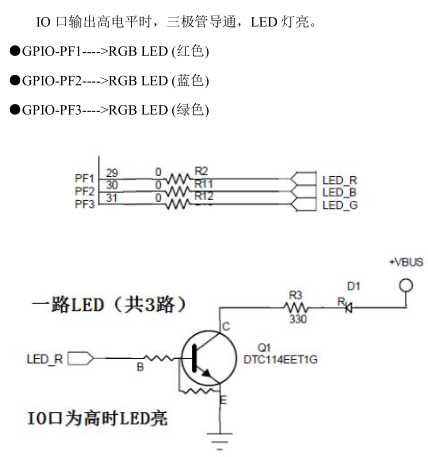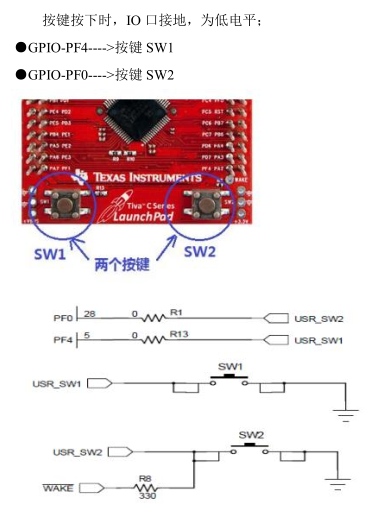GPIO of TM4C123G MCU
1. Output: Light up LED

Schematic diagram
IO port output high level light LED, next we learn how to control the high and low level of IO port.
- Method 1:
SysCtlPeripheralEnable(SYSCTL_PERIPH_GPIOF); //Port F peripheral enablement GPIOPinTypeGPIOOutput(GPIO_PORTF_BASE, GPIO_PIN_1); //PF1 is set to output GPIOPinWrite(GPIO_PORTF_BASE, GPIO_PIN_1, GPIO_PIN_1); //PF1 Output High Level
The corresponding PF1 is low:
GPIO PinWrite (GPIO_PORTF_BASE, GPIO_PIN_1, 0); //PF1 Output Low Level
- Mode two:
SysCtlPeripheralEnable(SYSCTL_PERIPH_GPIOF); GPIOPadConfigSet(GPIO_PORTF_BASE,GPIO_PIN_1,GPIO_STRENGTH_2MA,GPIO_PIN_TYPE_STD); GPIODirModeSet(GPIO_PORTF_BASE, GPIO_PIN_1, GPIO_DIR_MODE_OUT); GPIOPinWrite(GPIO_PORTF_BASE, GPIO_PIN_1, GPIO_PIN_1);
The two approaches are actually the same, because the GPIOPinTypeGPIOOutput function is encapsulated once again, so you can see its definition:
void GPIOPinTypeGPIOOutput(uint32_t ui32Port, uint8_t ui8Pins) { // // Check the arguments. // ASSERT(_GPIOBaseValid(ui32Port)); // // Set the pad(s) for standard push-pull operation. // GPIOPadConfigSet(ui32Port, ui8Pins, GPIO_STRENGTH_2MA, GPIO_PIN_TYPE_STD); // // Make the pin(s) be outputs. // GPIODirModeSet(ui32Port, ui8Pins, GPIO_DIR_MODE_OUT); }
You can see that it contains two functions, GPIOPadConfigSet and GPIODirModeSet. The detailed use of these two functions is explained in detail when learning GPIO input.
2. Input: Keyboard Detection

Schematic diagram
First, the IO port is initialized as input mode:
SysCtlPeripheralEnable(SYSCTL_PERIPH_GPIOF); GPIODirModeSet(GPIO_PORTF_BASE, GPIO_PIN_4, GPIO_DIR_MODE_IN); GPIOPadConfigSet(GPIO_PORTF_BASE,GPIO_PIN_4,GPIO_STRENGTH_2MA, GPIO_PIN_TYPE_STD_WPU);
Here are two functions of GPIODirModeSet and GPIOPadConfigSet
1. GPIODirModeSet mainly sets the direction of a port. Here we mainly look at the third parameter. There are several choices as follows:
#define GPIO_DIR_MODE_IN 0x00000000 // Pin is a GPIO input #define GPIO_DIR_MODE_OUT 0x00000001 // Pin is a GPIO output #define GPIO_DIR_MODE_HW 0x00000002 // Pin is a peripheral function
You can see the meaning of the name at a glance.
2. GPIOPadConfigSet Sets IO Port
Look at the choice of the third parameter:
#define GPIO_STRENGTH_2MA 0x00000001 // 2mA drive strength #define GPIO_STRENGTH_4MA 0x00000002 // 4mA drive strength #define GPIO_STRENGTH_6MA 0x00000065 // 6mA drive strength #define GPIO_STRENGTH_8MA 0x00000066 // 8mA drive strength #define GPIO_STRENGTH_8MA_SC 0x0000006E // 8mA drive with slew rate control #define GPIO_STRENGTH_10MA 0x00000075 // 10mA drive strength #define GPIO_STRENGTH_12MA 0x00000077 // 12mA drive strength
Setting current intensity
Look at the choice of the fourth parameter:
#define GPIO_PIN_TYPE_STD 0x00000008 // Push-pull #define GPIO_PIN_TYPE_STD_WPU 0x0000000A // Push-pull with weak pull-up #define GPIO_PIN_TYPE_STD_WPD 0x0000000C // Push-pull with weak pull-down #define GPIO_PIN_TYPE_OD 0x00000009 // Open-drain #define GPIO_PIN_TYPE_ANALOG 0x00000000 // Analog comparator #define GPIO_PIN_TYPE_WAKE_HIGH 0x00000208 // Hibernate wake, high #define GPIO_PIN_TYPE_WAKE_LOW 0x00000108 // Hibernate wake, low
That is, set push-pull, pull-down, which is generally used as output (GPIO_PIN_TYPE_STD), pull-up (GPIO_PIN_TYPE_STD_WPU) or drop-down (GPIO_PIN_TYPE_STD_WPD) as input.
After initializing the IO port as input mode, the level state of the IO port can be read.
GPIOPinRead(GPIO_PORTF_BASE, GPIO_PIN_4)
The return value of this function, taking PF4 as an example, when PF4 is 8 bits lower than the return value at high level: 00010000, that is 16. When the PF4 bit low level returns to 0.
Sample code
Function: Press the button to turn on the light and turn off the light.
#include <stdint.h> #include <stdbool.h> #include "inc/hw_gpio.h" #include "driverlib/gpio.h" #include "driverlib/pin_map.h" #include "inc/hw_memmap.h" #include "driverlib/sysctl.h" int main() { SysCtlPeripheralEnable(SYSCTL_PERIPH_GPIOF); //Set PF4 as pull-up input mode GPIODirModeSet(GPIO_PORTF_BASE, GPIO_PIN_4, GPIO_DIR_MODE_IN); GPIOPadConfigSet(GPIO_PORTF_BASE, GPIO_PIN_4, GPIO_STRENGTH_2MA, GPIO_PIN_TYPE_STD_WPU); //Set PF1 as output mode GPIOPinTypeGPIOOutput(GPIO_PORTF_BASE, GPIO_PIN_1); GPIOPinWrite(GPIO_PORTF_BASE, GPIO_PIN_1, 0); //Keyboard detection while(1) { //Not pressed for high level if(GPIO_PIN_4 == GPIOPinRead(GPIO_PORTF_BASE, GPIO_PIN_4)) GPIOPinWrite(GPIO_PORTF_BASE, GPIO_PIN_1, 0); //Be pressed else GPIOPinWrite(GPIO_PORTF_BASE, GPIO_PIN_1, GPIO_PIN_1); } }